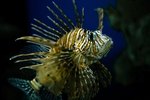
If your koi are looking sickly, acting lethargic or swimming slightly lopsided, chances are the nitrates in your pond are elevated. When your koi eliminate fecal matter, small amounts of ammonia are released into the water, adding up to a third of a teaspoon of ammonia for a 20-inch koi in a day's time. Bacteria convert the ammonia into less toxic nitrates, but it's crucial to keep levels in check to prevent algae overgrowth and eventual illness.
Subtract Ammonia Sources
The more fish you have in your koi pond, the more nitrates will wind up in the water. Don't overcrowd your koi, keeping one 20-inch fish per 500 gallons of pond water. Don't overfeed your fish. Not only does uneaten food decay on the bottom of the pond and cause more nitrates, but the more your fish eats, the more he will defecate, increasing nitrate levels more quickly.
Add Nitrate Eaters
Plants are a beautiful way to remove significant amount of nitrates in the water. Rapidly-growing plants such as watercress, irises, water lettuce and water lilies reduce nitrate levels the most rapidly, but may require extra care to keep your pond from becoming overgrown.
Getting Drastic
The only way to completely remove nitrates from your tank is to do a water change. A complete water change will shock your fish and spike ammonia levels until your tank has a chance to fully recover, a process that can take four to eight weeks. A series of 20 to 50 percent water changes every few days until nitrates are less than 50 parts per million is a safer way to remove excess nitrates.
References
Photo Credits
-
Art Wolfe/Photodisc/Getty Images
Writer Bio
Indulging her passion for vacation vagary through the written word on a full-time basis since 2010, travel funster Jodi Thornton-O'Connell guides readers to the unexpected, quirky, and awe-inspiring.




